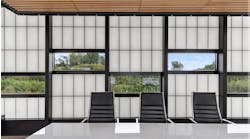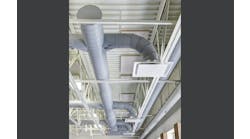Facility managers at schools and universities strive to provide environments that are healthful and conducive to learning; they also constantly seek ways to do so that won't break the bank.
Education institutions that are renovating and upgrading their infrastructures can take advantage of equipment, materials and strategies that boost energy performance and shave dollars from energy bills.
A common issue for schools is making sure classrooms and other learning spaces have adequate fresh air from outdoors. The U.S. Environmental Protection Agency (EPA) says that bringing outdoor air into a facility is the indoor-air-quality (IAQ) control “most associated with high energy cost.”
A report from the EPA, “Energy Efficiency and Indoor Air Quality in Schools,” recommends steps that education institutions can take to improve energy efficiency without detracting from air quality.
One solution is energy recovery ventilation (ERV) technology.
“ERV systems transfer energy between the inlet and exhaust streams as the building is being ventilated,” the EPA says. “Some systems transfer only heat energy, while others also transfer latent (moisture) energy through a desiccant coating or other means. Significant energy reductions can be achieved by reducing the energy requirements of conditioning the outdoor air, particularly during extreme weather conditions.”
ERV technology can reduce peak loads on heating and cooling equipment, and enable some schools to buy smaller and less expensive equipment. However, the EPA warns, some ERV systems may require more maintenance or additional filtration systems, which can increase the cost.
However, the EPA notes, in many climates “increased outdoor air ventilation rates can result in higher heating and air-conditioning costs and more indoor moisture problems.
“ERV systems are more economically viable in extreme climates, particularly in hot and humid climates where total energy recovery systems are employed to reduce moisture-related cooling loads,” the EPA says.
In a prototypical classroom wing of a school building in Miami, an energy-recovery system paid for itself in four years when calculated for a nine-month school year, the EPA says. For a wing used year-round with afternoon and evening classes, the payback would be achieved in less than two years.
To help schools determine if they would benefit from energy recovery ventilation technology, the EPA has developed the School Advanced Ventilation Engineering Software (SAVES) software package.
The package has two elements: The ERV Financial Assessment Software Tool (EFAST) helps determinewhether an ERV system makes financial sense for a school; the Indoor Humidity Assessment Tool (IHAT) helps measure how an ERV system will affect a school facility's indoor humidity.
Information about the software is available at www.epa.gov/iaq/schooldesign/saves.html.
Other energy-efficiency steps that may affect indoor air quality:
- Night pre-cooling
Cool evening air pre-cools a building and exhausts accumulated pollutants, the EPA says. To prevent microbiological growth, the system's controls should halt pre-cooling if the dew point of outdoor air is high enough to cause condensation on equipment.
- Variable air volume (VAV) systems
They can provide significant energy savings, but for VAV systems that provide a fixed percentage of outdoor air, when the supply air is reduced during part-load conditions, the amount of outdoor air may fall below applicable standards.
Some energy upgrades — those related to fans, motors, drivers and chiller/boiler systems — “generally have little impact on IAQ,” the EPA says. Tune-ups and maintenance of heating and cooling systems sometimes can improve IAQ by removing contaminant sources.
NOTABLE
15
In cubic feet per minute per occupant, the ASHRAE standard for outdoor air brought into a classroom.
25 to 30
In percent, potential energy cost savings schools can realize by following recommendations from the Energy Star Program for K-12 schools.
Source: U.S. Environmental Protection Agency.

